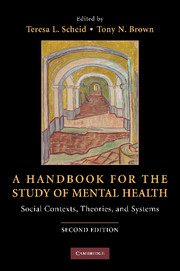Crossref Citations
This Book has been
cited by the following publications. This list is generated based on data provided by Crossref.
2010.
Publications Received.
Contemporary Sociology: A Journal of Reviews,
Vol. 39,
Issue. 3,
p.
369.
Watson, Dennis P.
and
Wright, Eric R.
2014.
The Wiley Blackwell Encyclopedia of Health, Illness, Behavior, and Society.
p.
1623.
Senda, Yukiko
2015.
Childbearing and Careers of Japanese Women Born in the 1960s.
p.
5.
Ludwig, Bernadette
and
Reed, Holly
2016.
“When you are here, you have high blood pressure”: Liberian refugees’ health and access to healthcare in Staten Island, NY.
International Journal of Migration, Health and Social Care,
Vol. 12,
Issue. 1,
p.
26.
McTernan, Wesley
Dollard, Maureen
Tuckey, Michelle
and
Vandenberg, Robert
2016.
Enhanced Co-Worker Social Support in Isolated Work Groups and Its Mitigating Role on the Work-Family Conflict-Depression Loss Spiral.
International Journal of Environmental Research and Public Health,
Vol. 13,
Issue. 4,
p.
382.
Goyal, Aishwarya
Singh, Shailendra
Vir, Dharam
and
Pershad, Dwarka
2016.
Automation of Stress Recognition Using Subjective or Objective Measures.
Psychological Studies,
Vol. 61,
Issue. 4,
p.
348.
Kotzmann, Jane
Bhatia, Neera
and
McMahon, Marilyn
2018.
A human rights-based approach to compulsory treatment of young people experiencing mental disorder.
Australian Journal of Human Rights,
Vol. 24,
Issue. 1,
p.
20.
Jose, Manju
2019.
Statistical analysis of social determinants of mental health problems.
Biometrics & Biostatistics International Journal,
Vol. 8,
Issue. 5,
p.
172.
Konyk, Katy
Ricciardelli, Rosemary
Taillieu, Tamara
Afifi, Tracie O.
Groll, Dianne
and
Carleton, R. Nicholas
2021.
Assessing Relative Stressors and Mental Disorders among Canadian Provincial Correctional Workers.
International Journal of Environmental Research and Public Health,
Vol. 18,
Issue. 19,
p.
10018.
Bowen, Deborah
Fernandez Poole, Senaida
White, Mary
Lyn, Rodney
Flores, Debra
Haile, Helen
and
Williams, David
2021.
The Role of Stress in Breast Cancer Incidence: Risk Factors, Interventions, and Directions for the Future.
International Journal of Environmental Research and Public Health,
Vol. 18,
Issue. 4,
p.
1871.
Ahmed Abdel-Al Ibrahim, Khaled
Mohammad Zaitoun, Zaheeh Saleh
Ajanil, Bemnet
and
Rezvani, Ehsan
2022.
Unemployment Anxiety in Light of the Coronavirus 2019 Pandemic and Its Relationship to Psychological Reassurance among Graduate Students at Prince Sattam Bin Abdulaziz University.
Education Research International,
Vol. 2022,
Issue. ,
p.
1.
Huft, Justin
2022.
The History and Future of the Sociology of Therapy: a Review and a Research Agenda.
The American Sociologist,
Vol. 53,
Issue. 3,
p.
437.
Petersen, Kimberly J.
Qualter, Pamela
Humphrey, Neil
Damsgaard, Mogens Trab
and
Madsen, Katrine Rich
2023.
With a Little Help from My Friends: Profiles of Perceived Social Support and Their Associations with Adolescent Mental Health.
Journal of Child and Family Studies,
Vol. 32,
Issue. 11,
p.
3430.
Xu, Changhao
Song, Yu
Sempionatto, Juliane R.
Solomon, Samuel A.
Yu, You
Nyein, Hnin Y. Y.
Tay, Roland Yingjie
Li, Jiahong
Heng, Wenzheng
Min, Jihong
Lao, Alison
Hsiai, Tzung K.
Sumner, Jennifer A.
and
Gao, Wei
2024.
A physicochemical-sensing electronic skin for stress response monitoring.
Nature Electronics,
Vol. 7,
Issue. 2,
p.
168.
Chadli, Sarra
Nechba Bennis, Rhita
Madani, Naoufel
El Fahime, ElMostafa
Abouqal, Redouane
and
Belayachi, Jihane
2024.
Psychological Distress Associated with Enforced Hospital Isolation Due to COVID-19 during the “Flatten the Curve” Phase in Morocco: A Single-Center Cross-Sectional Study.
Healthcare,
Vol. 12,
Issue. 5,
p.
548.
Pinheiro, Marta Frazão
Relva, Inês Carvalho
Costa, Mónica
and
Mota, Catarina Pinheiro
2024.
The Role of Social Support and Sleep Quality in the Psychological Well-Being of Nurses and Doctors.
International Journal of Environmental Research and Public Health,
Vol. 21,
Issue. 6,
p.
786.



